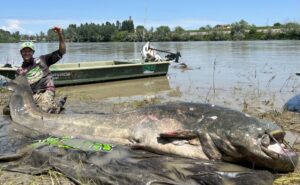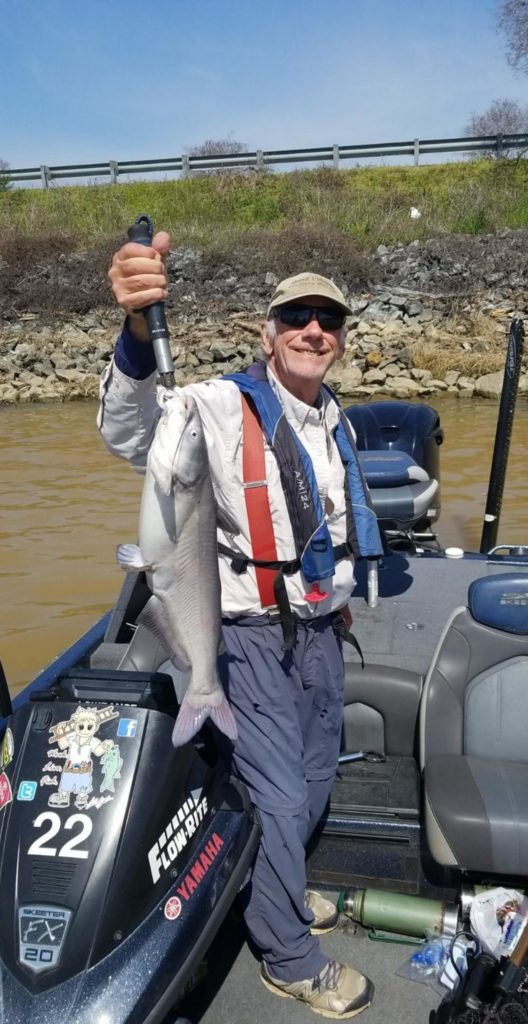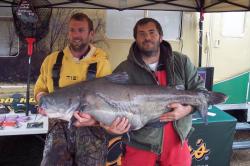How to Find and Catch Channel Cats
Editor’s Note: Here’s a useful novice level how-to for locating and catching one of the most widely-distributed fish in the nation, the channel cat, from the Iowa Department of Natural Resources.
from The Fishing Wire
Channel Catfish – What do I need?
Lake anglers use fairly short rods, while stream anglers like longer 6 to 8 feet rods. Some even use a fly rod. Longer rods offer better placement of the bait and lets you fish many good holes without casting. Just drop the line near a likely spot with no more line out than the rod length. Ten-pound test line is suggested over lighter weight line since the bait is fished on the bottom and often near underwater snags.
Match the reel to the fish. Light duty reels are made to catch small fish and heavy duty reels have the power to land lunkers. Light tackle will catch more smaller fish but may not handle one of record class size.
Terminal tackle is an important consideration when setting out after “old whiskers.” The sinker and hook is the most important part of the terminal tackle. Always use the lightest weight needed and a slip sinker. The slip sinker rig lets a catfish pick up the bait without feeling the weight of the sinker. With any resistance on the line, a channel cat will leave the tasty bait in search of another.
Use a sharp hook. Hooks with bait holders on the shank are preferred. Use sponges or plastic worms when fishing with soft, prepared cheese baits. Present your selected hook and bait to the fish in the most natural manner, which requires the use of a minimum amount of sinker or weight.
Circle hooks are popular when using live or cut bait. There is no need to “set the hook” as they are designed to hook the fish themselves. Slowly pull back on the rod when it starts to double over as the fish takes the bait. Quick hooksets typically result in missed fish. When used properly, circle hooks reduce the chance of the fish swallowing the bait as they are usually caught in the corner of the mouth.
Bait options range from nightcrawlers, leeches, chicken blood, chicken liver, chicken or fish guts, crawdads, grasshoppers, water dogs, live and dead minnows, cut bait and a variety of prepared “stink” baits. Prepared baits usually have one thing in common – cheese. Use cut bait or dead minnows in late winter and spring- just after ice-out. Made of half-rotten fish, use this bait when the water temperature is less than 60 degrees F. Catfish actively eat fish flesh and other animals that die during winter and sink to the bottom. The stronger the rotten odor of bait, the better the success. Fish in deeper areas of the lake or stream before ice melt then shift to shallow water that warms faster and draws catfish into the near-shore reaches. Catfish can be caught under ice conditions, but feeding begins in earnest after the water temperature reaches 40 degrees F.
A channel catfish’s keen sense of smell makes it one of the few game fish species that can be readily caught during high stream flows in the spring, summer, and early fall. Rising water levels often provide more food for channel catfish to eat by flooding terrestrial areas along the river and food being washed in from runoff. Fish become more active during this time. Catfish become less active when water levels fall. During times of stable or rising water levels nearly all baits will produce good catches of catfish. Use baits that are most available under natural conditions.
Easy to store prepared bait is one of the most popular catfish baits. Many catfish anglers switch to prepared baits when water temperatures warm to 70 degrees F and above. Prepared bait is most effective for pan-sized catfish in mid-summer (June, July and August). Use large-sized baits such as dead bluegill, live chubs, water dogs, crayfish and frogs when seeking larger catfish. Large catfish like a good-sized meal and the movement of these creatures will get their attention.
Channel Catfish – Tips and Tricks
Catfish eat a variety of food items and are attracted to “smelly” morsels. Smaller catfish (less than 14 inches) feed primarily on bottom-dwelling organisms, such as aquatic insect larvae and other invertebrates. As catfish grow, their diet changes and a wider variety of food items are eaten. Fish, alive or dead, make up the bulk of their food after they reach 16 inches.
Channel catfish diets vary with the seasons. A wide variety of organisms, including fish that died in the winter, are available in late winter and early spring. Catfish devour these morsels, in various stages of decomposition, in large quantities. It is not unusual to find catfish stomachs full of decaying fish shortly after ice-out. As the water warms into late spring and summer, aquatic and terrestrial worms, fish, frogs, crayfish, mulberries, insects and their larvae forms, elm seeds and algae are the most prevalent foods. Many other items are eaten but usually make up only a small portion of the menu. Catfish food choices change again in the fall as the water cools. More fish is eaten along with aquatic invertebrates and terrestrial insects. Frogs become an important food source as they move into streams before the onset of winter.
Streams and Rivers
Fish upstream of river snags and log jams and cast the bait back towards it so the scent of the bait is carried downstream into the structure by the current drawing the catfish out.
Channel catfish move into the deepest holes of a river in late fall to over-winter. Fish won’t be as aggressive as they are in the spring and summer because of the colder temperatures. Try cut bait or nightcrawlers on slip sinkers rigs fished near the bottom.
As June approaches, catfish begin to spawn. Male channel catfish will find a cavity in a rocky shoreline, snags or stump to make a nest to guard its eggs. The male channel catfish will defend the nest from other fish attacking it. Float live fish, crawlers, or leeches under a bobber along rip rap shorelines, stumps, snags or any other structure that may provide a cavity for the fish. Riprap shoreline with big boulders is best because of the bigger cavities it makes. Let the bobber rig drift in the current or with the wind close to the structure to lure the catfish out. Strikes are fairly aggressive so you need to set the hook quickly before the fish releases the bait.
Most midsummer Mississippi River fishing is done anchoring above snags along the main channel and side channels or above the wing dams in the main channel. Use slip sinker rigs fished on the bottom with stink bait or shad guts and nightcrawlers. Walleye anglers often catch channel catfish casting or trolling crankbaits on the wing dams in the summer.
Increase the weight of your sinker when fishing for Missouri River channel catfish and use cut bait, stink baits, crawdads and nightcrawlers. Try fishing the outside bends of old oxbows cut off from the river as this is where the deeper water will most likely be. Use slip sinker rigs fished on the bottom with stink bait or nightcrawlers in the summer.
Lakes & Reservoirs
During the spawn in early June, target channel catfish around rock structure that offer cavities for nesting. Many smaller lakes have rip-rap (rock) along the shoreline to protect the banks from erosion. Large rock is also placed on the dams of man-made lakes or impoundments to protect the dam from erosion. This large rock provides large cavities for channel catfish to make their nests. Drift minnows, night crawlers or leeches under a bobber along the rock.
As June approaches, channel catfish begin to spawn. Look for channel catfish along rocky shorelines that offer cavities for nesting. Large rock along the shoreline is best because it provides better cavities for nesting. Float bobber rigs along these rocky shorelines with live green sunfish, minnows, crawlers or leeches.
Buy Your Fishing Licenses Online
Channel Catfish
Channel catfish are found in nearly all Iowa lakes, ponds, streams and rivers. They are the most abundant game fish in our nearly 20,000 miles of interior streams.
Fish Details – Channel Catfish
(Characteristics, distribution, etc)
Channel Catfish – Where to Find Them
Streams and Rivers
Studies show that populations of 500 to over 5,000 pounds of catfish per mile in Iowa streams are common. Look for catfish in riffle areas just above pools, cut-banks, snags, rocks and other submerged structures in the stream. The outside edge of river bends usually has a cut-bank and deep water which hold large catfish populations. These outside bends usually have snags or log jams that provide good cover for catfish.
The Mississippi River has many areas that hold channel catfish including snags and log jams along the main channel and side channels, main channel wing dams, rip-rapped (rock armored) shorelines and shallow stump fields in the backwaters. Fishing typically begins in the spring as the ice goes out and channel catfish start to eat winterkilled shad. Many of the backwaters and shallow mudflats usually have dead shad that died that winter. Use cut bait or shad on the bottom in the mouths of these backwaters and shallow mudflats .
The Missouri River, heavily channelized with fast currents, has good numbers of channel catfish. Target the wing dike fields which create current seams, eddies, and sandbars that hold baitfish and aquatic invertebrates and attract channel catfish. Snags in the river hold channel catfish as well.
Lakes
Lakes have excellent catfishing thanks to an aggressive stocking program. Stocked fish grow fast and to a large size. The largest catfish caught in Iowa each year are taken from lakes and ponds. Fish over 10 pounds caught in our man-made lakes are common. Lake-dwelling catfish are not evenly spread but gather into specific locations. Most ponds and fishing lakes stratify into three distinct thermal layers 10 to 15 feet below the surface and water in the lower strata contains no oxygen – and no fish. Limit your fishing to depths above this stratification level. Streams that flow into the upper ends of lakes hold catfish, as does submerged structure such as timber, rock protected shorelines and drop-offs. Look for diverse habitat – the more diverse the habitat, the more attractive it is to catfish.
Large Reservoirs
Iowa’s large reservoirs offer great channel catfishing throughout the open water season. Fishing usually begins in the spring at ice out as channel catfish begin to eat gizzard shad that died over the winter. Focus fishing efforts towards the upper ends of the reservoirs fishing the shallower and warmer mudflats. Fish the windblown shorelines and points where the dead shad have been blown into to find actively feeding fish. Use cut shad or shad parts fished on the bottom.
Channel catfish move out along the channel edges of the reservoir in the summer and follow schools of shad to eat. With today’s advancements in sonar technology, many anglers will boat around until they find schools of shad. Usually there will be larger arcs on the sonar under the school of shad showing the presence of channel catfish or other predatory fish. Drift through the school of shad from the upwind side using lindy rigs/three-way rigs with cut bait fished on the bottom. You may have to move around some as the schools of shad and channel catfish move. Bends in the creek channel or drop offs near shallower stump fields are often good places as well. Catfish may also move up into these shallower stump fields or mudflats to feed at night.






